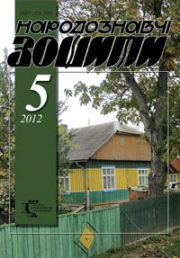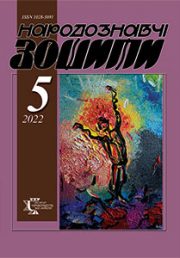The Ethnology Notebooks. 2017, 6 (138), 1549—1556
UDK 745.55: 391.7 (477.8)
DOI https://doi.org/10.15407/nz2017.06.1549
Received 15.11.2017
Fedynchuk Olga, assistant professor
of the Department of Decorative and Applied Arts
of the Fedkovych Chernivtsi National University,
master of artistic embroidery of the National Union of Masters of Folk Art of Ukraine
Nevsky Str., 3 b, Vyzhnytsia, Chernivtsi region, 59200, Ukraine
Contacts: Tel. (037)3022681; e-mail: decorative.applied.art@ukr.net
Abstract. In this article we consider a necklace in the Bukovina and Romanian complex jewelry of the XIX— XX centuries. The review of the literature indicates that the necklace of Northern Bukovina is insufficiently studied and requires artistic exploration, as well as less illuminated artistic features, stylistics, and morphology. Due to the remoteness of the region, Bukovina and Romanian necklaces did not become the subject of special researches.
Keywords: necklace, coral, pearls, Venetian necklace, glass necklace.
REFERENCES
ChMNAP KV4235/PR22.
ChMNAP KV5187/PR47.
ChMNAP KV1671/PR10.
ChMNAP KV450/PR2.
ChMNAP KV1904/PR2.
ChMNAP KV6533/PR56.
ChMNAP KV4606/PR40.
ChMNAP KV7088/DRK280.
ChMNAP KV4565/PR37.
ChOKM KV1808/M86.
ChOKM (ekspozytsiia).
ChOKM 32999III20832.
ChOKM 31214III19487.
ChOKM 17195III12202
ChOM 17197III12204.
ChOKM 17198III12205.
ChOKhM KV1809/M87.
ChOKhM KP418/M27.
ChOKhM KV/350 Hr226.
Volik, K. (2013). Dukachi v istorychnomu konteksti ta kul’turnomu prostori Ukrainy: sotsium, symvolika, semiotyka. Bulletin of Kharkiv State Academy of Design and Arts, 4, 54—57. [in Ukrainian]
Vrochyns’ka, H. (2007). Ukrains’ki narodni zhinochi prykrasy XIX — pochatku XX stolit’. Kyiv : Rodovid. [in Ukrainian]
Zapasko, Ya. P. (Ed). (2000). Dekoratyvno–uzhytkove mystetstvo: Slovnyk (Vol. 2). L’viv : Afisha. [in Ukrainian]
Kozholianko, H. (1999). Etnohrafiia Bukovyny (Vol. 1). Chernivtsi : Zoloti lytavry. [in Ukrainian]
Kozholianko, Ya. (1994). Bukovyns’kyj tradytsijnyj odiah. Chernivtsi ; Saskatun : Friesen Printers ; Altona ; Manitoba. [in Ukrainian]
Korally v juvelirnom iskusstve. (2008). Vіsnik juvelіra Ukrainy, 3, 56—57. [in Russian]
Kostyshyna, M. (1996). Ukrains’kyj narodnyj kostium Pivnichnoi Bukovyny: tradytsii i suchasnist’. Chernivtsi : Ruta. [in Ukrainian]
Matejko, K. (1963). Ukrains’kyj narodnyj odiah. Narodna tvorchist’ ta etnohrafiia, 2, 63—64. [in Ukrainian]
Nedashkivs’ka, H. (1988). Koraly v narodnomu vbranni. Narodna tvorchist’ ta etnohrafiia, 5, 56—58. [in Ukrainian]
Pyvovarov, S. (2004). Monestva, dukachi, zghardy, salby — prykrasy bukovynok pozamynuloho stolittia. Svoboda slova, 18 (47), 17. [in Ukrainian]
Fedorchuk, O. (2007). Ukrains’ki narodni prykrasy z biseru. L’viv : Svichado, 2007. [in Ukrainian]
Shmahalo, R. (2015). Khudozhnij metal v Ukraini: mynule, suchasne, majbutnie (Vol. 1). L’viv : Apriori. [in Ukrainian]
Shukhevych, V. (1997). Hutsul’schyna: persha i druha chastyna (repryntne vyd. 1899 r.). Kyiv : Verkhovyna. [in Ukrainian]
Banateanu, T., Fosca, G. & Lonesco, E. (1956). L‘arte populaire dans la republique populaire roumaine. Bucureşti : Éditions d’Etat pour La Litterature et l’Art.
Banateanu, Т. (1975). Arta Populara Bucovineana. Bucureşti : Fondul Plastic.
Bechmann, H. (2010). ORO — 6.000 ani fra storia e leggenda. Bergamo : Bolis.
Buzilă, B. (2011). Costumul popolar din republica Moldava. Chişinău.
Camera di Comercio Industria, Artiginato e Agricoltura di Roma: Ogetti preziosi e orologeria (1985). Roma : Romana Editrice.
Costinea, V. (2007). Valea Siretului: copere etnografici din zona Storojinet. Timişoara : Artpress.
Domenici, V. (1978). Natura e medicina: la perle. Airone, 78, 34. Milano : Elcograf.
Laurentiu, D. (2004). Crasna: un colt de etermitate romaneasca din Bucovina. Bucureşti : Editura Coralia.
Nicorici, L. (2007). Arta giuvaiergeriei din Republica Moldova: Teză. Chişinău.
Treccani, G. (Ed.). (1989). Dizionario encyclopedico Italiano. Milano : Arti Grafici Ricordi.
Treccani, G. (Ed.). (1987). Dizionario encyclopedico Italiano. Milano : Arti Grafici Ricordi.
Antonescu, R. Dicşionar de simboluri şi credinşe tradişionale romăneşti. Retrieved from http://cimec.ro/Etnografie/Antonescudictionar (Last accessed: 19.09.2017).






